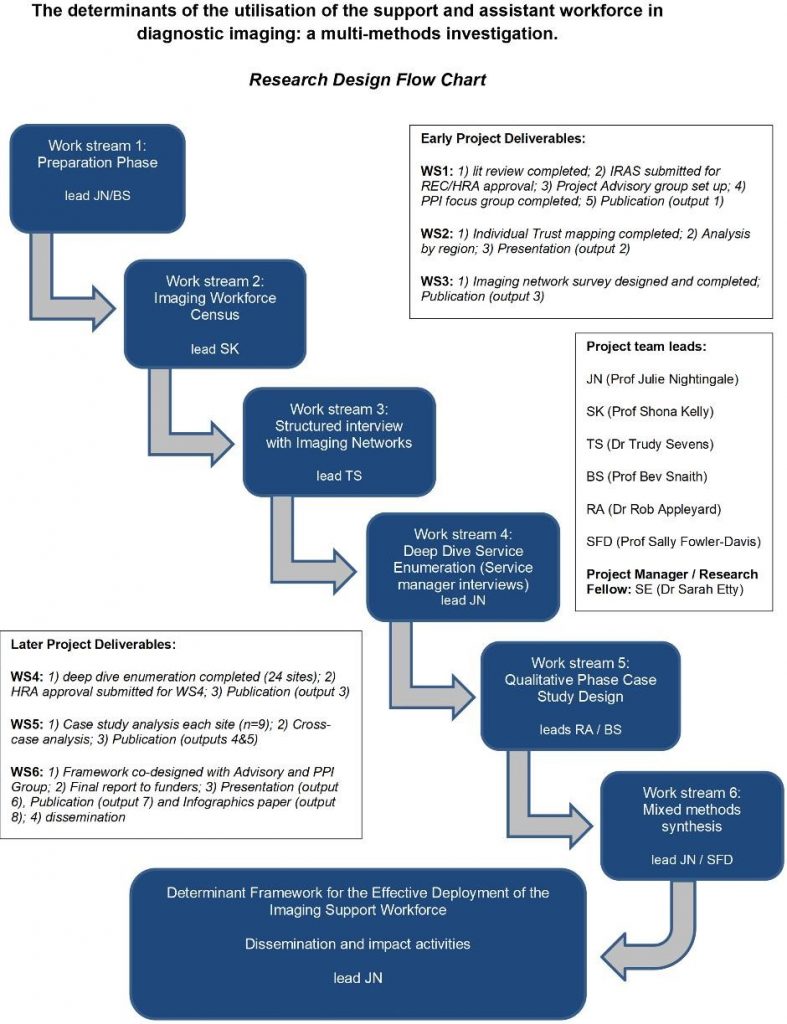The ‘I-SWAP’ study: The determinants of the utilisation of the support and assistant workforce in diagnostic imaging: a multi-methods investigation.

The use of medical imaging for diagnosing disease has increased dramatically in recent years. The more complex, costly and time-consuming investigations such as Computed Tomography (CT) and Magnetic Resonance Imaging (MRI) have seen the greatest increase in demand. This increase means patients are having to wait longer for their imaging appointment and for the results. The Covid-19 pandemic has made the situation worse because many non-urgent imaging services (including cancer screening programmes) were suspended for several months. In February 2021, 12 times as many patients in England were waiting over 6 weeks for a CT, MRI or ultrasound scan than in February 2020. Having to wait for an investigation increases people’s anxiety. In some cases it can also have more serious consequences, because the disease may have worsened during that time and the treatments used to combat the disease may be less effective.
The pandemic (and people exiting the NHS for other reasons) has led to significant staff shortages, reducing the number of scans that can be carried out. Efforts are being made to train, employ and keep more staff in the imaging services. However, this is not sufficient to deal with the backlog of scans, and the increased workload in future. We need to urgently review how the different types of imaging staff work together, and in some cases provide training to allow some staff to take on other job roles, allowing the service to work more efficiently. This “skills mix” will mean that the abilities and knowledge of all staff members are used to their fullest extent, and the most effective and efficient service can be delivered to patients.
We have noticed a big variation in how different hospitals use support workers and assistants in their imaging departments. Some employ very few support workers, while others have used them in many interesting ways. Our project will investigate where and how support workers are used across all imaging services in England. This will highlight those organisations with effective skill mix approaches where support workers are enabling radiographers to take on advanced roles. We will then explore what has helped and what has prevented imaging departments employing these workers. We will share this learning with all the imaging services to support them to adopt a more efficient way of working which will improve services to patients.
Our project will use a ‘mixed methods’ approach which will review existing NHS imaging workforce figures alongside new information collected through a census and a survey of selected hospitals and regional networks. We will explore the findings further through a ‘case study’ of selected Imaging Departments, involving interviews and focus groups with key staff. The data will be combined to produce a model of practice to guide the future deployment of the support and assistant imaging workforce. Please see further detail on each workstream below:
Workstreams
The project has 6 work packages, referred to as workstreams (WS):
–WS1) Preparatory stage;
This stage involves gaining approval from different institutions (Sheffield Hallam University, Health Research Authority), the setting up of various groups such as our patient and public involvement (PPI) group and Study Steering Committee, and the writing up of a literature review.
–WS2) Census of imaging workforce (~137 sites);
This stage analysed Employee Staff Record (ESR) workforce data for radiology services. This analysis allowed the exploration into the proportion of support workers and assistant practitioners in radiology services. This, in turn, allowed the categorisation of all the NHS trusts in to high, medium, and low adopters of support workers and assistant practitioners, which enabled the identification of 8 trusts from each category to be recruited for interview in workstream 4.
–WS3) Survey of imaging networks (n=22);
This workstream aims to identify regional/system-level approaches to recruitment, education and training, competency assessment, supervision and deployment of the support & assistant workforce, by interviewing representatives from imaging networks. This, in addition to workstream 2, will assist in identifying the 24 NHS trusts selected for recruitment into workstream 4.
–WS4) Deep dive review of selected Trusts (24 sites);
Workstream 4 builds on previous workstreams by asking Radiology Service Managers (RSMs), or their representatives, to complete an electronic survey about workforce numbers, followed by a semi-structured online interview that explores the utilisation of their support and assistant workforce. These interviews will enable the selection of 9 sites to approach for recruitment into workstream 5.
–WS5) Qualitative case study phase (9 sites);
Workstream 5 will use a collective case study approach involving a series of nine individual case studies (imaging services). This will involve two researchers conducting a two-day site visit to each of the case study sites for data collection purposes. The researchers will undertake a review of local support and assistant workforce service documentation, focus groups with representatives from the support and assistant workforce, and one or two interviews with supervisors / modality leads and operational managers.
–WS6) Development of a Framework for Practice.
This mixed methods project will yield a large quantity of quantitative and qualitative data. Each workstream will yield specific findings to address different research objectives. These findings need to be compared, contrasted and amalgamated in this final workstream. Synthesis of the findings will enable the creation of a Determinant Framework for the deployment of the support and assistant imaging workforce. A Determinant Framework provides a mechanism to specify individual determinants which act as barriers and enablers that influence implementation outcomes. The aim is to understand, explain and predict influences on the effective implementation of the support and assistant workforce outcomes.
